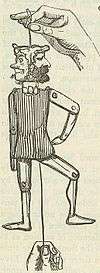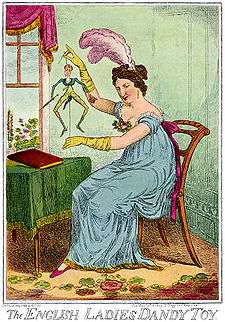Jumping jack (toy)
The jumping jack is a toy whose origins date back thousands of years. The jointed jumping jack figure is a cross between a puppet and a paper doll. The figures are generally made from wood and their limbs are jointed and tied to a pull string. When the string is pulled and released, the arms and legs move up and down.


History
Although the jumping jack is popularly thought of as a European toy, ivory dancer figures made to spin by pulling their strings, which were found at the archaeological site El Lisht and date back to ancient Egyptian times, are considered to be among the earliest forms of this family of mechanical toys.
Jumping jacks were popular in many countries including England and Germany, where they were known as Hampelmann. In France they were especially popular and generally known as “pantins”.[1]
In the mid-1700s, “pantins” were popular among the French nobility.
In 1832 the Hampelmann was created by Carl Malss as a figure for the burlesque at Frankfurt am Main. Later the jumping jack toy became known as Hampelmann in German-speaking countries. They were manufactured in the Erzgebirge mountain range in Germany.[2]
In 1926, in her first year as a student at the famous Bauhaus design school in Dessau, Germany, the textile designer Margaretha Reichardt undertook a preliminary course run by Josef Albers and László Moholy-Nagy.[3] As part of the course she designed a modern version of the Hampelmann, which was later produced commercially by Naef, a Swiss toy company. Her version is set in a wooden frame, but like traditional Hampelmänner he has articulated limbs that move when a string is pulled.[4]
Quockerwodger
Oxford Reference cites the word "quockerwodger" as "a wooden puppet which can be made to 'dance' by pulling its strings".[5] By analogy, quockerwodger came to be used for a politician whose "strings" are pulled entirely by their own "puppetmaster".[6]
External links
| Wikimedia Commons has media related to Jumping jack. |
| Look up jumping-jack in Wiktionary, the free dictionary. |
References
- https://wepa.unima.org/en/jumping-jack/
- Dtv-lexikon, Deutscher Taschenbuch Verlag, Munich, 1971, vol. 8, p. 169
- Bauhaus100.com. Margaretha Reichardt Retrieved 31 October 2018
- Formost.de. Margaretha Reichardt. Retrieved 31 October 2018
- Oxford Reference. Quockerwodger. Retrieved 31 October 2018
- Susie Dent. Twitter. Retrieved 4 June 2020